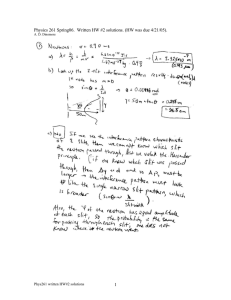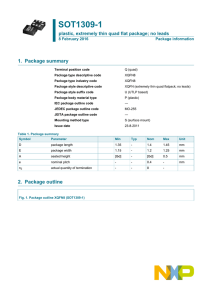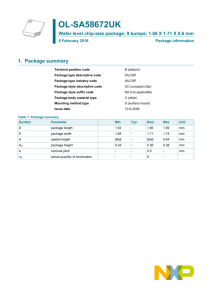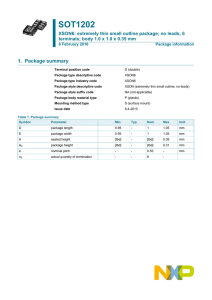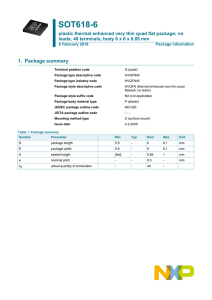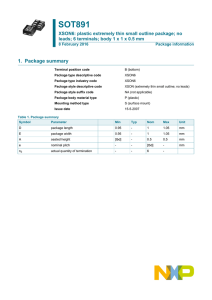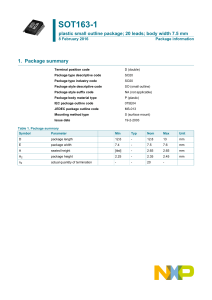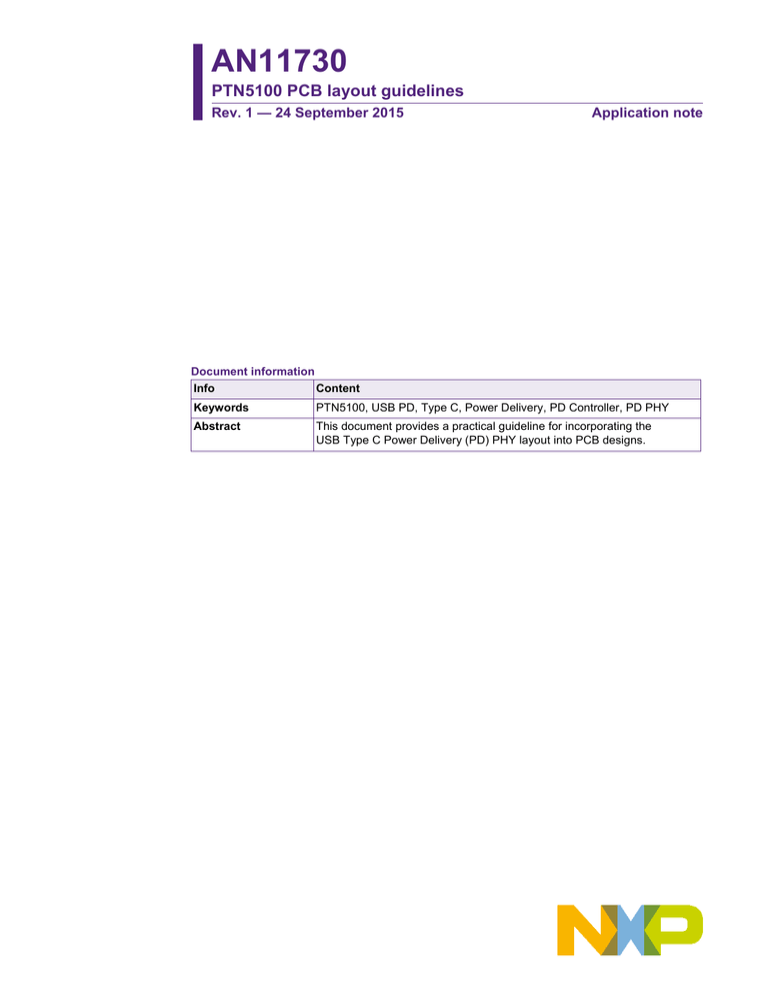
AN11730
PTN5100 PCB layout guidelines
Rev. 1 — 24 September 2015
Application note
Document information
Info
Content
Keywords
PTN5100, USB PD, Type C, Power Delivery, PD Controller, PD PHY
Abstract
This document provides a practical guideline for incorporating the
USB Type C Power Delivery (PD) PHY layout into PCB designs.
AN11730
NXP Semiconductors
PTN5100 PCB layout guidelines
Revision history
Rev
Date
Description
1
Initial version
20150924
Contact information
For more information, please visit: http://www.nxp.com
AN11730
Application note
All information provided in this document is subject to legal disclaimers.
Rev. 1 — 24 September 2015
© NXP Semiconductors N.V. 20154. All rights reserved.
2 of 9
AN11730
NXP Semiconductors
PTN5100 PCB layout guidelines
1. Introduction
This document provides a practical guideline for incorporating the USB Type C Power
Delivery (PD) PHY layout into a Printed Circuit Board (PCB) design.
These are general guidelines related to the layout of the PTN5100 only and not the
power supply unit that can deliver up to 100 W across the type C cable. The PTN5100 is
used to control the power switching devices (FETs, load switches…), and the power
supply is responsible to generate the power rails that switch into VBUS.
2. PTN5100 interconnection PCB layout
PTN5100 is a 20 pin device and the layout guidelines below group them into separate
groups depending on the function of the pins.
2.1 SPI Host Interface
2.1.1 Clock Signal Routing
PTN5100 supports SPI clock as high as 30 MHz. The rising and falling edges of the clock
signal tend to be very short, therefore, the standard signal integrity PCB layout rules
should be incorporated for reliable data transfer on the SPI bus. The following
recommendations should be taken into account when routing the clock signal.
• The spacing between the clock trace should be three to four times away from other
signal to minimize cross talk to keep the clock clean from noises.
• Minimize the use of vias to reduce PCB trace impedance changes that would
create signal reflection.
• Route clock trace with controlled impedance, normally a 50 ohm PCB trace.
• The clock signal should be routed straight and avoid any sharp bend that creates
signal reflection.
2.1.2 Data Signal Routing
• The SPI data in and data out signals should be routed with identical length as the
clock signal. This will keep the propagation delay the same between the clock and
the data lines to ensure reliable data transfer on the SPI bus.
• The data signal should be routed with the same controlled impedance as the clock
signal - 50 ohm.
• Avoid any sharp bend and route the signal at 45 degree angle instead.
2.2 FET controls
The power switching device such as power FETs or load switches are controlled directly
by PTN5100. Even though these power switching devices must handle current of 5 A or
more, the control signals carry a few mA or less and they are just static signals (just on
and off).
When the power switching devices are in the off state, these signals might have high
voltage transition on them when the cable is plugged in. Keep these signals three to four
times the width of the PCB trace away from other traces.
AN11730
Application note
All information provided in this document is subject to legal disclaimers.
Rev. 1 — 24 September 2015
© NXP Semiconductors N.V. 2015. All rights reserved.
3 of 9
AN11730
NXP Semiconductors
PTN5100 PCB layout guidelines
2.3 CC1 and CC2
These signals are used as the communication channels between two USB PD devices.
They are also being used to deliver power (VCONN) to a type C cable’s imbedded
electronic if they are not used as the communication channel.
• The spacing between CC1 and CC2 traces should be three to four times away from
other signal to minimize cross talk to keep these signals clean from noises.
• Follow SPI clock and data routing to avoid signal reflection
• VCONN current can be as high as 1.2 A (6 W), therefore, these PCB traces must be
designed to handle this much current. PCB trace width of more 20 mil is
recommended if the standard 1Oz copper pour is used.
2.4 VCONN_IN
• VCONN_IN is the power supply that is used to provide power to power cable. To
avoid high frequency noise signal from coupling into the electronic circuit in the
cable, a 100 pF and a 0.1 uF capacitors are recommended to bypass this pin.
• Follow the placement recommendation in 2.5 to place these decoupling capacitors.
• VCONN current can be as high as 1.2 A (6 W), therefore, this PCB trace must be
designed to handle this much current. PCB trace width of more 20 mil is
recommended if the standard 1 Oz copper pour is used.
• Keep VCONN_IN trace away from any high speed signal. The rule of three to four
times the trace spacing from another signal should be applied.
2.5 POWER SUPPLY PINS – VIO and VDD
• PTN5100 has two power supply input pins – VIO is the supply for the I/O ring and
VDD is the supply for the device’s internal circuitries. Use one 0.1 uF and one
0.01 uF ceramic capacitors (0603 or 0402 size) to decoupling each supply pin. The
coupling capacitors should be places as close as possible to each supply pin, this will
minimize the inductive resistance creates by the length of the PCB trace.
• The routing of the power supply traces from the package pin to the decoupling
capacitors should be short, and wide. Each capacitor should have its own via to the
ground plane. Avoid sharing the same ground via between the two capacitors.
AN11730
Application note
All information provided in this document is subject to legal disclaimers.
Rev. 1 — 24 September 2015
© NXP Semiconductors N.V. 2015. All rights reserved.
4 of 9
AN11730
NXP Semiconductors
PTN5100 PCB layout guidelines
Fig 1.
Power supply pins
2.6 V_MCUPWR
V_MCUPWR comes from the PTN5100 internal LDO to provide power to the external
microcontroller which acting as a host to the PTN5100.
• To avoid high frequency noise signal from coupling into external microcontroller, a
2.2 uF and a 0.1 uF capacitors are recommended to bypass this pin.
• Follow the placement recommendation in 2.5 to place these decoupling capacitors.
• The PCB trace to the external microcontroller should be as wide as and direct as
possible.
2.7 BYPASS
• This is the PTN5100 internal power rail bypass pin. A low ESR 2.2uF ceramic
capacitor is required. A ceramic capacitor such as Murata GRM188R61C225KE15D
or equivalent should be used.
• Place the bypass capacitor as close as possible to the pin.
• Follow the recommendation in 2.5.
2.8 HWQFN/HVQFN exposed center pad solder lands
The center pad under the device is used as the device’s ground pin, as well as thermal
relieve. This center pad must be connected to the system ground.
During reflow soldering, solder paste melts and gas or trapped air is released, causing
splattering or solder balling. Solder balling and splatter can be minimized if the solder
paste is printed as a number of individual dots, instead of one large deposit, and if the
solder paste is kept at a sufficient distance from the edge of the solder land.
The solder paste pattern area about should cover 30 % of the solder land area. When
printing solder paste on the exposed die pad solder land, the solder paste dot area
should cover no more than 20 % of this solder land area. Furthermore, the paste should
be printed away from the solder land edges. This is illustrated in figure below; the solder
paste pattern area lies within the boundary indicated by the red line and it is divided by
the entire solder land area.
AN11730
Application note
All information provided in this document is subject to legal disclaimers.
Rev. 1 — 24 September 2015
© NXP Semiconductors N.V. 2015. All rights reserved.
5 of 9
AN11730
NXP Semiconductors
PTN5100 PCB layout guidelines
Fig 2.
Solder paste dot area
3. Summary
• Standard signal integrity PCB layout should be applied to minimize cross talk, signal
reflection.
• VCONN and CC1/CC2 PCB traces must be designed to carry at least 1.2 A of
current.
• The PTN5100 center pad is utilized as the ground pin, therefore, it must be
connected to the system ground.
• The center pad should be divided into smaller pads to minimize soldering issue.
• A low ESR ceramic capacitor is required on the BYPASS pin.
4. Reference
1. USB PD Specification Revision 2
AN11730
Application note
All information provided in this document is subject to legal disclaimers.
Rev. 1 — 24 September 2015
© NXP Semiconductors N.V. 2015. All rights reserved.
6 of 9
AN11730
NXP Semiconductors
PTN5100 PCB layout guidelines
5. Legal information
5.1 Definitions
Draft — The document is a draft version only. The content is still under
internal review and subject to formal approval, which may result in
modifications or additions. NXP Semiconductors does not give any
representations or warranties as to the accuracy or completeness of
information included herein and shall have no liability for the consequences
of use of such information.
5.2 Disclaimers
Limited warranty and liability — Information in this document is believed to
be accurate and reliable. However, NXP Semiconductors does not give any
representations or warranties, expressed or implied, as to the accuracy or
completeness of such information and shall have no liability for the
consequences of use of such information. NXP Semiconductors takes no
responsibility for the content in this document if provided by an information
source outside of NXP Semiconductors.
In no event shall NXP Semiconductors be liable for any indirect, incidental,
punitive, special or consequential damages (including - without limitation lost profits, lost savings, business interruption, costs related to the removal or
replacement of any products or rework charges) whether or not such
damages are based on tort (including negligence), warranty, breach of
contract or any other legal theory.
Notwithstanding any damages that customer might incur for any reason
whatsoever, NXP Semiconductors’ aggregate and cumulative liability
towards customer for the products described herein shall be limited in
accordance with the Terms and conditions of commercial sale of NXP
Semiconductors.
Right to make changes — NXP Semiconductors reserves the right to make
changes to information published in this document, including without
limitation specifications and product descriptions, at any time and without
notice. This document supersedes and replaces all information supplied prior
to the publication hereof.
Suitability for use — NXP Semiconductors products are not designed,
authorized or warranted to be suitable for use in life support, life-critical or
safety-critical systems or equipment, nor in applications where failure or
malfunction of an NXP Semiconductors product can reasonably be expected
to result in personal injury, death or severe property or environmental
damage. NXP Semiconductors and its suppliers accept no liability for
inclusion and/or use of NXP Semiconductors products in such equipment or
applications and therefore such inclusion and/or use is at the customer’s own
risk.
Applications — Applications that are described herein for any of these
products are for illustrative purposes only. NXP Semiconductors makes no
representation or warranty that such applications will be suitable for the
specified use without further testing or modification.
Customers are responsible for the design and operation of their applications
and products using NXP Semiconductors products, and NXP
Semiconductors accepts no liability for any assistance with applications or
AN11730
Application note
customer product design. It is customer’s sole responsibility to determine
whether the NXP Semiconductors product is suitable and fit for the
customer’s applications and products planned, as well as for the planned
application and use of customer’s third party customer(s). Customers should
provide appropriate design and operating safeguards to minimize the risks
associated with their applications and products.
NXP Semiconductors does not accept any liability related to any default,
damage, costs or problem which is based on any weakness or default in the
customer’s applications or products, or the application or use by customer’s
third party customer(s). Customer is responsible for doing all necessary
testing for the customer’s applications and products using NXP
Semiconductors products in order to avoid a default of the applications and
the products or of the application or use by customer’s third party
customer(s). NXP does not accept any liability in this respect.
Export control — This document as well as the item(s) described herein
may be subject to export control regulations. Export might require a prior
authorization from competent authorities.
Translations — A non-English (translated) version of a document is for
reference only. The English version shall prevail in case of any discrepancy
between the translated and English versions.
Evaluation products — This product is provided on an “as is” and “with all
faults” basis for evaluation purposes only. NXP Semiconductors, its affiliates
and their suppliers expressly disclaim all warranties, whether express,
implied or statutory, including but not limited to the implied warranties of noninfringement, merchantability and fitness for a particular purpose. The entire
risk as to the quality, or arising out of the use or performance, of this product
remains with customer.
In no event shall NXP Semiconductors, its affiliates or their suppliers be
liable to customer for any special, indirect, consequential, punitive or
incidental damages (including without limitation damages for loss of
business, business interruption, loss of use, loss of data or information, and
the like) arising out the use of or inability to use the product, whether or not
based on tort (including negligence), strict liability, breach of contract, breach
of warranty or any other theory, even if advised of the possibility of such
damages.
Notwithstanding any damages that customer might incur for any reason
whatsoever (including without limitation, all damages referenced above and
all direct or general damages), the entire liability of NXP Semiconductors, its
affiliates and their suppliers and customer’s exclusive remedy for all of the
foregoing shall be limited to actual damages incurred by customer based on
reasonable reliance up to the greater of the amount actually paid by
customer for the product or five dollars (US$5.00). The foregoing limitations,
exclusions and disclaimers shall apply to the maximum extent permitted by
applicable law, even if any remedy fails of its essential purpose.
5.3 Trademarks
Notice: All referenced brands, product names, service names and
trademarks are property of their respective owners.
All information provided in this document is subject to legal disclaimers.
Rev. 1 — 24 September 2015
© NXP Semiconductors N.V. 20154. All rights reserved.
7 of 9
AN11730
NXP Semiconductors
PTN5100 PCB layout guidelines
6. List of figures
Fig 1.
Fig 2.
Power supply pins ............................................. 5
Solder paste dot area ........................................ 6
AN11730
Application note
All information provided in this document is subject to legal disclaimers.
Rev. 1 — 24 September 2015
© NXP Semiconductors N.V. 2015. All rights reserved.
8 of 9
AN11730
NXP Semiconductors
PTN5100 PCB layout guidelines
7. Contents
1.
2.
2.1
2.1.1
2.1.2
2.2
2.3
2.4
2.5
2.6
2.7
2.8
3.
4.
5.
5.1
5.2
5.3
6.
7.
Introduction ......................................................... 3
PTN5100 interconnection PCB layout ............... 3
SPI Host Interface .............................................. 3
Clock Signal Routing .......................................... 3
Data Signal Routing ........................................... 3
FET controls ....................................................... 3
CC1 and CC2 ..................................................... 4
VCONN_IN......................................................... 4
POWER SUPPLY PINS – VIO and VDD............ 4
V_MCUPWR ...................................................... 5
BYPASS ............................................................. 5
HWQFN/HVQFN exposed center pad solder
lands .................................................................. 5
Summary .............................................................. 6
Reference ............................................................. 6
Legal information ................................................ 7
Definitions .......................................................... 7
Disclaimers......................................................... 7
Trademarks ........................................................ 7
List of figures....................................................... 8
Contents ............................................................... 9
Please be aware that important notices concerning this document and the product(s)
described herein, have been included in the section 'Legal information'.
© NXP Semiconductors N.V. 2015.
All rights reserved.
For more information, visit: http://www.nxp.com
Date of release: 24 September 2015
Document identifier: AN11730

